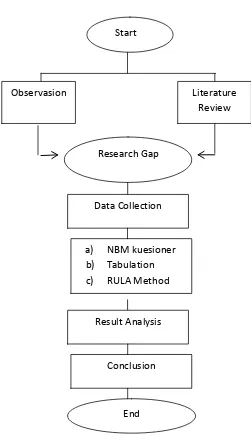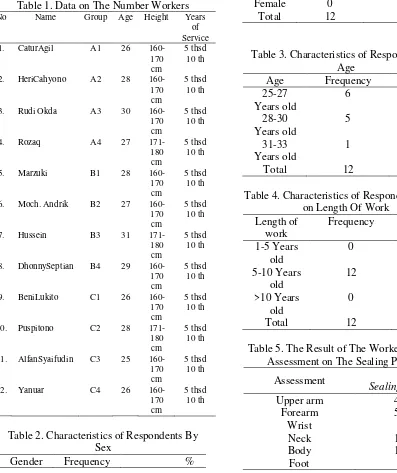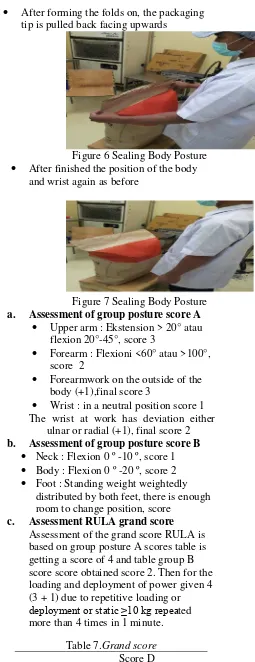p-
ISSN 2622-2027
e
-ISSN 2622-2035
34|TiBuana, Vol. 01, No. 1, 2018
INFLUENCE OF REPETITIVE WORK ON WORK PRODUCTIVITY ON
DEPARTMENT OF PACKAGING
DjokoAdiWalujo*)
*)
Industrial Engineering Department, Faculty of Industrial Technology University of PGRI Adi Buana Surabaya
email :[email protected]
Abstract
Sealing process requires an ergonomic attitude in work. If work posture is not ergonomic it can cause musculoskeletal system disorders. The purpose of this research to know the effect of repetitive work on work productivity on sealing activities in the packaging department based on RULA method. Data collection is done by direct observation and interview. Data obtained are analyzed, then the acquisition of grand scores is categorized based on the action level of the RULA. The posture of sealing process in the packaging department is in the fourth level action category which means that there is need for investigation and possible repairs.
1. INTRODUCTION
Some of the activities experienced by the workers in increasing the use of mechanization, automation at the speed of work, and the optimization of production capacity give some impact on the worker's body on the physical and psychic. Measurement methods used in improving the work system of workers in the packaging department is with nordic body map questionnaire, rapid upper limb assessment.
The nordic body map questionnaire is a questionnaire used to find out the inconvenience of the workers at work and the nordic body map questionnaire has been widely used by ergonomics experts to assess the severity of disorders of the skeletal and muscle systems and have considerable validity and reliability (Tarwaka, 2010). While the rapid upper limb assessment is a method developed in the field of ergonomics and can
be used quickly to assess the working position or posture of the neck, back, arms of an operator's wrist and leg. In addition, this method is also influenced by coupling factors, external burden is supported by the body and worker activity. The assessment using the rapid upper limb assessment did not take long to complete and scoring general on the list of activities indicating the need for risk reduction caused by the operator's work posture (McAtamney, 2000).
Research on the effect of repetitive work in increasing the use of mechanization, automation at the speed of work, and the optimization of production capacity, is done to twelve workers in the packaging department with the following working methods, packaging process, sealing (cover packaging); checking sealing results (ensuring packaging in airtight conditions); and sew the packaging to look neat. Based on the above problems, this study aims to find out repetitive work can reduce the productivity of work in the packaging department.
Based on the above problems, this study aims to find out repetitive work can reduce the productivity of work in the packaging department. Some literature reviews include repetitive work, repetitive movements, theories about nordic body maps, Rapid Upper Limb Assessment (RULA), and previous researchers.
2. LITERATURE REVIEW
abdomen to the neck or upper limbs.
This method does not require special equipment in the assessment of posture of the neck, back and upper arms. Each movement is given a predefined score to facilitate the assessment of body posture, the body is divided into 2 group segments that are group A and group B.
Rating Group Posture Body A consists of four parts that is:
• Upper Arm
Assessment is made on the angle formed by the upper arm according to the position of the torso during the work activity. • Forearm
Assessment is performed on the angle formed by the forearm according to the position of the torso during the work activity.
• Wrist
Assessment is made on the angle formed by the wrist according to the position of the forearm while performing work activities.
• Wrist Round
For a round of wrists neutral posture is given a score:
1 = The middle position of the round 2 = On or near from round
The values of the upper arm posture, forearm, wrist and wrist round are inserted into Group A's posture chart to obtain a score.
• Added Activity Score
After the results obtained score for group A posture, then the score is added to the score of activity.
are added with the load score.Rating Group Posture Body B consists of five parts that is:
• Neck
Assessment is done to the position of the neck during the work activities whether the operator must perform extension or flexibility with a certain angle. • Trunk
Assessment of the angle that the spine is formed in the body while performing work activities with a slope that has been classified. • Legs
Assessment is done to the position of the foot during work activities whether the operator works with a normal position / balanced or resting on one leg straight.
The scores of posture neck, torso and foot posture scores are inserted into group B posture charts for a score.
• Addition of activity score
After the results obtained score for group B posture, then the score results are added with the score of activity.
• Addition of load scores
Scores of additions with activity scores are added with the load score.
p-
ISSN 2622-2027
e
-ISSN 2622-2035
36|TiBuana, Vol. 01, No. 1, 2018
3. RESEARCHMETHODOLOGY
Figure 1.Flowchart Troubleshooting Literature
Review Observasion
Research Gap
Data Collection
a) NBM kuesioner b) Tabulation c) RULA Method
Result Analysis
Conclusion
No Name Group Age Height Years
Table 2. Characteristics of Respondents By Sex
Gender Frequency %
Total 12 100
Table 3. Characteristics of Respondents By Age
Table 4. Characteristics of Respondents Based on Length Of Work
>10 Years old
0 0
Total 12 100
Table 5. The Result of The Worker's Posture Assessment on The Sealing Process
Assessment
Table6. Tabulation of Nordic Body Map Questionnaire Based on Types of Pain Complaints on Sealing Process
Complaint Type
Group code by worker name
p-
ISSN 2622-2027
e
-ISSN 2622-2035
38|TiBuana, Vol. 01, No. 1, 2018 Pain in right upper
arm
√ √ √ √ √ √ √ √ √ √ √ √
Pain in the waist √ √ √ √ √ √ √ √ √ √ √ √
Pain in the buttocks Pain in the butt
Pain in the left thigh Pain in the right
5. RESULT and DISCUSSION 5.1. Research Description
• Job Description
This work posture research is done to employees of departmental packaging company on sealing job. In the packaging department is the work done is packing a good finish in the form of creamer into 25 kg paper bag packaging which then through several processes to be forwarded to the warehouse. In the sealing process itself is a continuation of the filling process is the initial process of packing the product into 25 kg packaging. Workers on this sealing process are in charge of fireplaces packing paper bags by folding the ends of open packaging. On sealing work is done by one person according to work instructions. The employee achievement targets at the packaging department are 2000 bags per shift. The activity is performed with a
standing position within 12 hours of work with rest time every 1 hour for 10 minutes. Heavy paper bags that have not filled the product 0.326kg and heavy paper bag that has been filled 25kg product. The results of this observation were measured using RULA method with documentation of worker's posture while doing sealing job. The documentation of the image is then assessed using a score score and a grand score. Then determined the level of action or action level. So it can be known steps to be taken related to the acquisition of grand scores on sealing jobs.
5.2. Data Analysis
Figure 2 Sealing Body Posture
• Once ready, both wrists hold the packaging and the head is bowed slightly looking into the packaging.
Figure 3 Sealing Body Posture • The folding process is done by holding
the top end of the open package, then pulling right to the right and left wrists for the left wrist.
Figure 4 Sealing Body Posture • After being pulled to the right and to the left, then pushed or bent forward with the second position of the wrist still clutching the end of the pack
Figure 5 Sealing Body Posture
Figure 6 Sealing Body Posture • After finished the position of the body
and wrist again as before
Figure 7 Sealing Body Posture
a. Assessment of group posture score A
• Upper arm : Ekstension > 20° atau flexion 20°-45°, score 3
• Forearm : Flexioni <60° atau >100°, score 2
• Forearmwork on the outside of the body (+1),final score 3
• Wrist : in a neutral position score 1 The wrist at work has deviation either
ulnar or radial (+1), final score 2
b. Assessment of group posture score B
• Neck : Flexion 0 º -10 º, score 1 • Body : Flexion 0 º -20 º, score 2 • Foot : Standing weight weightedly
distributed by both feet, there is enough room to change position, score
c. Assessment RULA grand score
Assessment of the grand score RULA is based on group posture A scores table is getting a score of 4 and table group B score score obtained score 2. Then for the loading and deployment of power given 4 (3 + 1) due to repetitive loading or
deployment or static ≥10 kg repeated more than 4 times in 1 minute.
Table 7.Grand score Score D
p-
ISSN 2622-2027
e
-ISSN 2622-2035
40|TiBuana, Vol. 01, No. 1, 2018
2 2 2 3 4 4 5 5 Based on the results of the grand score analysis above, the final score obtained is 7. Where in the action level of the job is 4 which means that investigation and improvement is needed as soon as possible.
6.
Conclusion
Based on the description of data
processing from the report of posture
analysis of workers on the sealing process
made by 12 employees in the packaging
department can be summed up as follows:
a.
The final score is based on the RULA
method
The sealing process causes pain
complaints with a score of 4 on group
A's posture score. In addition,
experiencing pain complaints with
score 2 on group B post score, score 8
on score C and score 6 on score D for
grand scoring RULA score got score 7
meaning necessary investigation and
repair as soon as possible.
b.
Results from Nordic Body Map
•
Prior to work, 12 workers did not
engage in work activities which
meant that they did not have a
working risk level.
•
After work 12 workers received a
grand score score of RULA with a
score of 7 which means that
investigations and repairs are
needed as soon as possible.
•
The most common complaints on
the upper part of the neck, lower
neck, left shoulder, right shoulder,
upper left lengabn, right upper
lengabn, back, waist, left elbow,
right elbow, left wrist, right wrist,
hand left, right hand, left knee,
right knee, left calf, right calf, left
ankle, right ankle, left foot, right
foot.
c.
To improve the working method
causing some pain complaints it is
necessary to change the working
method.
References
1. Nurmianto, E. (1998), Ergonomi-Konsep Dasar dan Aplikasinya. Edisi 1, GunaWidya, Surabaya.
2. Sugiyono. (2012), Memahami Penelitian Kualitatif. Bandung: ALFABETA. 3. Suma’mur P.K., Dr, Msc. (1981),
Keselamatan Kerja dan Pencegahan
Kecelakaan, PT. TokoGunungAgung: Jakarta.
4. Suma’mur P.K., Dr, Msc. (1988), Hygiene Perusahaan dan Kesehatan. CV. Haji Mas Agung, Cetakan ke6. Jakarta.
5. Tarwaka, Solichul, Lilis Sudiajeng. Ergonomi Untuk Keselamatan, KesehatanKerja, danProduktivitas. Surakarta: Universitas Brawijaya Press. 2004.
6. Tarwaka. Dasar-Dasar Pengetahuan Ergonomi dan Aplikasi di Tempat Kerja. (Solo: Harapan Press Solo, 2010).
7. Tarwaka. (2011), Ergonomi Industri, Harapan Press, Solo.


